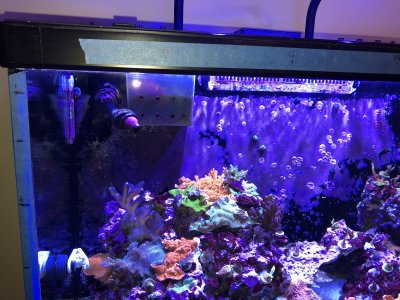- Joined
- Aug 16, 2018
- Messages
- 15
- Reaction score
- 25
I was curious about the PAR values in my RSM C-250 with the Kessil AP700. I used the Apogee SQ-520. I roughly gridded out the tank using painters tape and a ruler.

Measurements:
Depth below water at 1, 6, 12 and 18 (sandbed) inches.
Width from back at 3, 6, 9, 12 and 15 inches.
Length from left at 6, 12, 18, 24 and 30 inches.
The AP700 is mounted about 7.5 inches above the water. The two light pucks extend about 6 inches into the tank's width and sit at 12 and 24 inches from the left. I chose the 5th light preset on the Kessil app and bumped the intensity to 100%. Light diffusers were removed and pumps were turned off for all measurements.
Each of the charts represent measurements taken at a different depth. As an example, box (L12,W6) would represent the spot direct below the left puck.

Empty boxes are areas where rock or coral are. Some of the measurement spots are areas that are likely shaded by coral so the numbers do seem to jump around.
I didn't bother recording measurements at the sides because numbers had such a range to not be useful and I consider the area to be mostly unused. However, the PAR peaked at about 150 on either side at about 12 inches deep and 9 inches from back so will likely place frag racks there.
I placed major diffusers on the lights and took some measurements at depth 6 inches. These measurements seemed to be about 25% lower. Out of curiosity, I measured point ( L24,W12) at depth 6 inches with the pumps on. The PAR fluctuated between 170 and 270.
I have to say that the measurements surprised me as I thought the readings would have been higher and I was being super cautious. I actually had this light with diffusers running at 60% and 9 inches above water before I started taking measurements. I think I'll bring it up to 80% and see how it goes.

Measurements:
Depth below water at 1, 6, 12 and 18 (sandbed) inches.
Width from back at 3, 6, 9, 12 and 15 inches.
Length from left at 6, 12, 18, 24 and 30 inches.
The AP700 is mounted about 7.5 inches above the water. The two light pucks extend about 6 inches into the tank's width and sit at 12 and 24 inches from the left. I chose the 5th light preset on the Kessil app and bumped the intensity to 100%. Light diffusers were removed and pumps were turned off for all measurements.
Each of the charts represent measurements taken at a different depth. As an example, box (L12,W6) would represent the spot direct below the left puck.
Empty boxes are areas where rock or coral are. Some of the measurement spots are areas that are likely shaded by coral so the numbers do seem to jump around.
I didn't bother recording measurements at the sides because numbers had such a range to not be useful and I consider the area to be mostly unused. However, the PAR peaked at about 150 on either side at about 12 inches deep and 9 inches from back so will likely place frag racks there.
I placed major diffusers on the lights and took some measurements at depth 6 inches. These measurements seemed to be about 25% lower. Out of curiosity, I measured point ( L24,W12) at depth 6 inches with the pumps on. The PAR fluctuated between 170 and 270.
I have to say that the measurements surprised me as I thought the readings would have been higher and I was being super cautious. I actually had this light with diffusers running at 60% and 9 inches above water before I started taking measurements. I think I'll bring it up to 80% and see how it goes.















